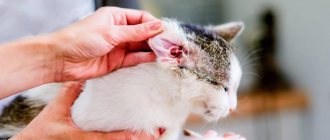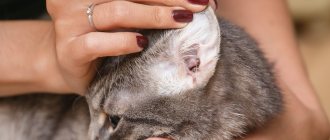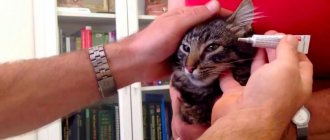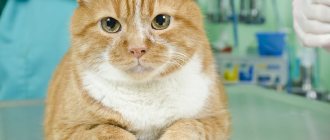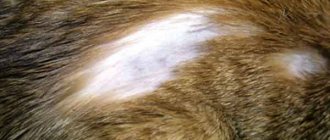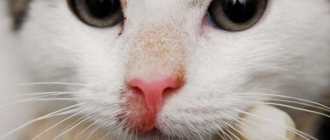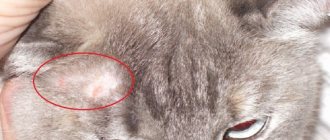What is ringworm?
Ringworm is an infectious skin disease caused by the parasitic fungi Microsporum canis and Trichophyton tonsurans, it is part of the group of ringworms that primarily affect the skin, hair and nails. This is an infectious dermatological pathology caused by dermatophyte fungi. It is also called dermatomycosis, scab, micro- and dermatophytosis.
Doctors distinguish several types of ringworm, depending on the location, nature of the course and the causative agent.
The main types of the disease are:
- chronic or ringworm of smooth skin;
- surface;
- ringworm of the nail plate;
- infiltrative-suppurative.
Since ringworm is caused by two types of fungi, in medicine it is diagnosed as microsporia and trichophytosis. These fungi have persistent pathogenicity, pronounced virulence and often cause acute diseases with varied clinical manifestations.
A disease caused by fungi of the genus Microsporum canis is microsporia. Depending on the location, there is microsporia of smooth skin and microsporia of the scalp.
Trichophytosis is caused by the activity of the dermatophyte Trichophyton tonsurans, which, through the anthroponotic route of infection, causes inflammation of the scalp and smooth skin, and through the zootroponotic route, inflammation in the deep layers of the dermis, accompanied by suppuration.
The presence of fungal spores does not always provoke damage to the skin and its appendages. The transition of the fungus from an inactive state to a pathogenic state is facilitated by metabolic and endocrine disorders, immune diseases, hypovitaminosis or vegetative-vascular dystonia. This increase in the pathogenicity of dermatophytes provokes an exacerbation of inflammatory processes, the spread of the fungus through the blood and lymph flow.
The disease is weakly expressed during the development of a latent infection and when localized in previously affected areas, and the high virulence of the fungus is formed during a relapse, gradually decreasing during the course of the infection.
Symptoms of ringworm: At the end of the incubation period, itchy ring-shaped spots of red-pink color appear on the skin, on the surface of which bubbles appear, after which a crust and peeling remain. The hair at the site of the lesion breaks and falls out.
Normally, the immune system is able to cope with the pathogen and prevent its activity, but there are a number of factors that increase the risk of ringworm, namely:
- skin microtraumas;
- lack of vitamins and microelements;
- prolonged contact with the source of infection;
- high humidity and air temperature;
- exacerbation of chronic diseases, etc.
In a situation where there is an adult or child with lichen at home, it is necessary to take preventive measures to reduce the likelihood of its spread, namely:
- use separate towels and bed linen;
- wash your hands thoroughly with soap, especially if you touched the patient’s things;
- use gloves when touching areas of disease;
- undergo examination and take tests to identify pathogens, etc.
The main method for diagnosing ringworm is the use of a Wood's lamp, under the light of which the affected areas acquire a characteristic greenish glow. Microscopic examination and culture of skin and hair scales are effective to confirm the diagnosis.
Timely diagnosis and a properly selected treatment regimen can effectively eliminate ringworm in children and adults, preventing its spread. The pathology is prone to relapse, since the presence of spores of viable fungi can cause repeated damage. It is extremely important to complete the course of treatment and follow all doctor’s recommendations.
Signs of trichophytosis
Perhaps the most severe type of mycosis of the scalp is in the hair growth area, as a result of which the patient loses hair. Differentiate between superficial and deep forms.
With superficial trichophytosis, you can first detect flaky lesions and brittle hair at the base of the follicles, as a result of which the scalp is covered with black dots. On the remainder of the hair after breaking, you can notice a gray coating. The affected areas may become red, itchy, and swollen.
The deep form manifests itself as general malaise, hyperthermia; an infected person may notice swelling and tenderness of the lymph nodes, and a rash. Pink-red spots can be found on the scalp, rising above the surface of the epidermis. They have clear contours and a round shape. The most abundant peeling is observed along the contour of the spot. Less commonly, vesicles (bubbles with liquid) can form along the contour. Such lesions spread quite quickly, which is highly likely to lead to an abscess.
How is ringworm transmitted?
Ringworm is transmitted in two ways:
- from a sick animal – zoonotic with an incubation period of one week;
- from an infected person – anthroponotic with an incubation period of up to 6 weeks.
Children are at risk because they most often come into contact with the carriers of the pathogens of this disease - cats and dogs. Children's skin is characterized by low density of the stratum corneum and weak protective properties of the water-lipid mantle. The stratum corneum prevents the penetration of the fungus into the layers of the skin, since its spores are located between the horny scales, and the water-lipid mantle forms a barrier to the penetration of pathogens.
The infection is also transmitted by non-compliance with personal hygiene standards and the use of other people's personal belongings containing fungal spores (hats, combs, bed linen, etc.).
Can you get shingles from a cat?
Feline lichen is transmitted to another animal or person mainly through contact and household contact. Infection can also occur in other ways:
- lichen is transmitted from person to person through objects of regular use (combs, towels);
- in the absence of disinfection of grooming tools in animal salons;
- can be transmitted from cat to person through contact with fur;
- through soil in which the pathogen persists for up to 3 months;
- when working with hay that contains hair from a sick animal.
The risk of contracting lichen from a cat increases with the presence of certain factors:
- low immunity;
- frequent stress, prolonged depression;
- prolonged contact with an infected person;
- constant care of sick animals;
- lack of personal hygiene;
- contact of a child with a lichen-infected cat;
- presence of dermatological diseases.
How does ringworm begin?
Favorable conditions contribute to the introduction and reproduction of a pathogenic fungus in the skin, triggering the infectious process. In the initial stages, this period is asymptomatic. After which the development of the pathology acquires clinical manifestations, the signs of which depend on the stage of the pathology.
The stages of the infectious process during the development of ringworm are:
- incubation period;
- period of mushroom growth;
- refractory stage (period of insensitivity, rest);
- regression.
In the skin, the fungus forms branched mycelium, which gradually invades new areas of the skin, while old lesions become the location of its spores. This period of fungal growth is determined by the rapid increase in the colony of the pathogen, active division of skin cells and the high rate of exfoliation of the affected epidermis.
Since most often the growth of the colony outstrips the rate of change of the stratum corneum, the infectious process spreads. An intense immune reaction (inflammation) in the lesion is displayed in the form of a red ring, which, in the chronic course of mycosis, becomes the permanent residence of the pathogen.
How does infection occur?
Most often, ringworm affects children aged 4 to 15 years. Parents should be vigilant and ensure that their child does not pick up stray animals on the street.
Most often they become infected from:
- street kittens and cats;
- animals purchased at bird markets or secondhand from the metro;
- stray dogs.
It is extremely unlikely to bring ringworm from a nursery, and in order to officially sell an animal, you need a veterinary certificate. When registering, animals must be checked for dermatomycosis.
A person can become infected with lichen from a cat in several ways:
- The largest number of spores of fungal organisms is present on the surface of the skin and fur of an infected animal.
- Infection with spores can occur through scales, fur, or dander that falls from the animal.
- Sandboxes, places where house dust accumulates (if there was a person or animal in the house with ringworm), soft toys that have been exposed to spores - all this remains contagious for a long time, up to 18 months.
Note! The incubation period for lichen can be up to several months. All this time, the person or animal will be infectious, but this will not be noticeable.
The peculiarities of ringworm infection led to the fact that in the USSR, in order to protect people, animals with dermatomycosis were euthanized. Now such a measure is considered inhumane, but then it was justified. Over the past 20 years, pharmacology has made significant progress, and now the infectivity of a pet is significantly reduced after the first treatment with an antifungal drug. However, until the cat is completely cured, that is, until the culture of fungi from the lesions becomes sterile and new lesions do not form in the cat, the risk of becoming infected from it still exists.
Find out how to treat lichen in cats>>>
What does ringworm look like?
Clinical manifestations of ringworm depend on the type of pathogen, course and stage of the disease. Dermatophytes secrete enzymes and toxins that destroy keratin protein (they feed on it), so the severity of symptoms directly depends on the ability of fungi to produce these substances.
Common symptoms of ringworm on the scalp are:
- hair thinning;
- the appearance of localized peeling of the skin;
- redness of the epidermis;
- hair breaking off at the root;
- the appearance of small bubbles with cloudy contents along the edges of bald patches, after opening which yellow crusts form.
Ringworm of smooth skin includes the following symptoms:
- pronounced itching;
- the appearance of round red spots;
- light epidermis at the site of damage, surrounded by gray scales;
- the edges of the damaged area consist of pink-red bubbles;
- growth of the lesion in diameter.
The chronic form of the disease is accompanied by the presence of microscopic blisters on the affected areas, the formation of scars after their opening and severe itching. In a situation where the site of the lesion is the nail plate, its separation, discoloration and thickening are observed.
Ringworm of the infiltrative-suppurative form is characterized by the appearance of large bright red spots up to 10 cm in diameter, the outer surface of which is lumpy and uneven, and purulent follicles form along the edges. Pain, swelling and hyperemia of the affected areas are also observed.
The appearance of the first signs of the disease requires a mandatory visit to a dermatologist. The lack of qualified treatment can lead to the rapid spread of infection throughout the body and cause a number of complications: tissue scarring, death of hair follicles, allergic reactions and the addition of a secondary infection.
Symptoms of pityriasis
Clinical manifestations of pityriasis rosea are caused by exposure to infectious pathogens and the development of allergic reactions. The skin disease is manifested by the following symptoms:
- General weakness, enlarged lymph nodes, elevated body temperature.
- The formation on the body of small pinkish and mauve spots that have a symmetrical shape and appear along Langer’s lines. Rashes appear on the back, limbs, chest, neck, groin and other parts of the body.
- The appearance on the skin of 2-3 bright red maternal plaques (their diameter is 4 cm), dotted with scales. After a week, small pink rashes form from these large spots.
- Dropout spots spread throughout the body and increase in size (their diameter is 1-2 cm), can peel off, and resemble medallions in shape.
- Severe skin itching.
- Increased irritability.
With proper therapy, the symptoms of pityriasis disappear after 5-8 weeks, and the patient fully recovers. Longer therapy is required if the rash has dense nodules, blisters or papules. In exceptional cases, pityriasis rosea turns into eczema, purulent inflammation of the skin, folliculitis, streptococcal infections, etc. develop. The development of complications is facilitated by the patient’s excessive sweating, a tendency to allergies, constant friction of the skin and improper treatment.
How is ringworm treated?
In each case, treatment for ringworm should be selected individually, since its composition and duration have their own specifics and are determined by the type, location and stage of the pathology.
Only prescriptions from a dermatologist are effective; they take into account the current clinical picture, the characteristics of the patient’s physical health and his age.
Therapy is aimed not only at relieving the symptoms of the pathology, but also at inactivating the pathogen. The chronic form of the disease also provides support for the immune system, normalization of metabolism and hormonal levels.
The following groups of drugs are used to treat ringworm:
- systemic and local antimycotics;
- antiseptic solutions;
- multivitamin complexes.
Treatment
The combination of drugs prescribed to the patient depends on the severity of damage to the skin, nail plates and hair follicles. Antifungal therapy may be local or general. In the first case, a child or adult needs to use creams and ointments that suppress the activity of the microsporia pathogen. Drugs in this group are not recommended for use by girls during pregnancy and lactation. Topical sprays are effective in treating large areas of ringworm. Modern formulations do not leave stains on the skin and are not absorbed into the fabric of clothing.
A severe inflammatory reaction is treated with a combination of antifungal and hormonal drugs. Patients will have to apply ointment applications to the affected areas. After this, the skin is treated with iodine solutions. The oral tablet intake schedule is formed by a dermatologist based on the clinical picture of the pathology.
The addition of a secondary infection to microsporia involves the use of drugs based on betamethasone, gentamicin or clotrimazole.
How long does it take to treat ringworm?
The treatment process for ringworm is lengthy, usually taking at least six weeks, with systemic therapy lasting mainly 15-25 days.
The effectiveness of therapy is assessed using laboratory tests. In a situation where tests indicate a significant decrease in the number of fungal spores after 2 weeks of a medication course, it is necessary to continue the chosen treatment. In some cases, fungal shedding can last for several months.
After the signs of pathology disappear, you need to scrape the epidermis three times in previously damaged areas:
- immediately after completion of therapy;
- 7 days after therapy;
- after 2-3 months.
The result of therapy is considered successful if all three tests show negative results.
Which doctor should I consult with this disease?
You should first contact a therapist, then an infectious disease specialist or dermatologist. If the form of herpes is severe, the help of a neurologist is necessary; if the eyes are affected, the help of an ophthalmologist is necessary.
We recommend making an appointment at the neurological department of the RAS clinic (Moscow). The best doctors will examine you, study the signs of the disease, identify the causative agent of the infection, make a diagnosis, conduct a consultation, issue clinical recommendations and prescribe effective treatment.
Don't put off visiting a specialist! Specialists from the neurological department of the Central Clinical Hospital of the Russian Academy of Sciences in Moscow remind you: any symptoms that worry you are a reason to consult a neurologist. In this case, the doctor will be able to recognize and treat the disease at an early stage, before the situation worsens and becomes irreversible. You can make an appointment with a neurologist by calling the clinic or using the form on the website.
How to treat ringworm in children?
Treatment of ringworm in a child is the responsibility of a pediatric dermatologist, since the characteristics of the child’s body require special doses and composition of medications.
Hygiene and child care are also important elements of pathology therapy:
- boiling and ironing clothes in contact with affected areas of the skin;
- treating household surfaces with disinfectants to prevent the spread of spores;
- frequent change of bed linen;
- washing in the shower rather than the bath, etc.
Can I go to work or school with ringworm?
The presence of this diagnosis requires isolation of the patient from the team for at least two weeks. In schools and other children's institutions, it is mandatory to notify parents for timely detection of the disease in other children.
The disappearance of ringworm symptoms and 3 negative tests for the presence of fungus are a reason to return to school or work.
If a dermatomycosis infection has been detected in a team, then to prevent pathology, you can use antifungal shampoos for some time, carry out wet cleaning with the addition of antiseptic solutions, and strictly observe personal hygiene.
- Treatment of lichen in Kharkov;
- treatment of lichen in Uzhgorod;
- treatment of deprivation in Sumy;
- treatment of lichen in Poltava;
- treatment of lichen in Odessa;
- treatment of deprivation in Nikolaev;
- treatment of lichen in Mariupol;
- treatment of deprivation in the Dnieper.
3
1
0
Article rating:
3.8 out of 5 based on 5 ratings
Author: Mangusheva Victoria Yurievna
Dermatovenerologist, cosmetologist, trichologist. Candidate of Medical Sciences, doctor of the highest category. Work experience more than 10 years.
Treatment of lichen at home
To cure your pet you will need to follow a number of rules:
- The room where the cat is kept must be regularly cleaned and disinfected. Sterility is the enemy of fungi;
- ointments and sprays are used to treat foci of the pet’s disease 2-3 times a day for 2 weeks;
- wash the cat with antifungal shampoos twice a week for 6 weeks;
- Injections against feline lichen . There are contraindications for pregnant women, nursing kittens and kittens under 2 months. The prices for lichen vaccines for cats are low, but the effect is excellent;
- the use of griseofulvin, itraconazole, and ketonazole tablets. The drugs are given every 12 hours at a dose of 5-10 mg per 1 kg of body weight;
- stains can be treated with iodine, which will promote their speedy healing.

